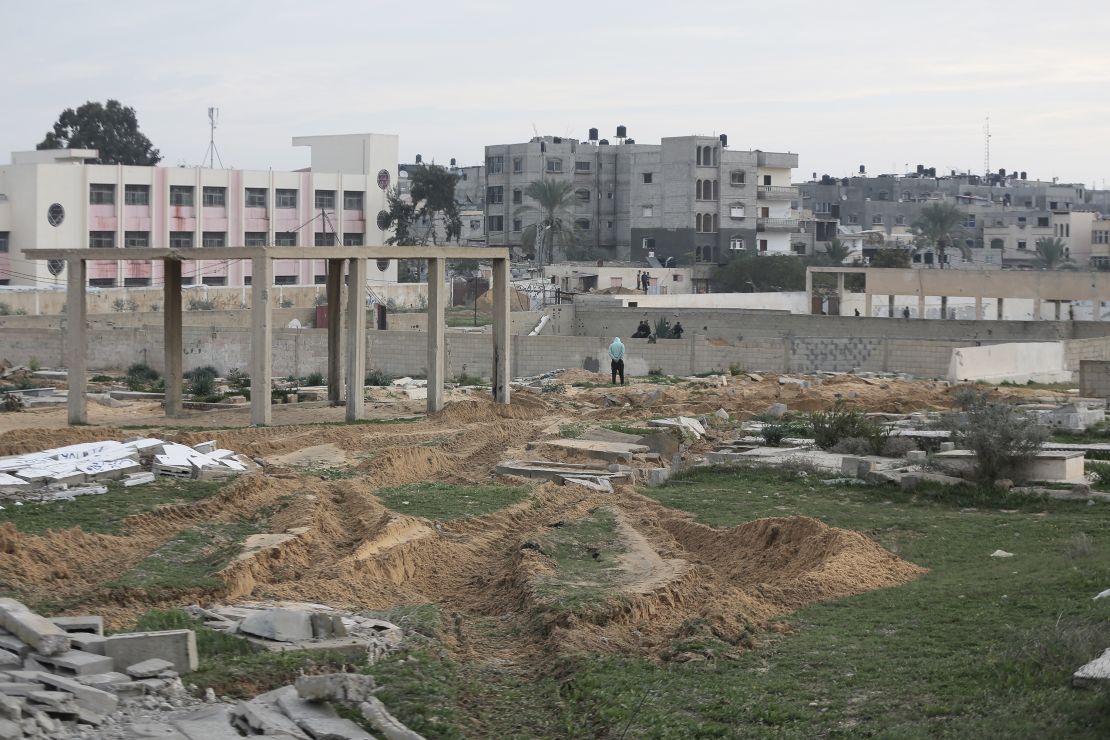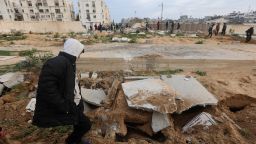At least 16 cemeteries in Gaza have been desecrated by Israeli forces, satellite imagery and videos reveal
The Israeli military has desecrated at least 16 cemeteries in its ground offensive in Gaza, a CNN investigation has found, leaving gravestones ruined, soil upturned, and, in some cases, bodies unearthed.
In Khan Younis, in southern Gaza, where fighting escalated earlier this week, Israeli forces destroyed a cemetery, removing bodies in what the Israel Defense Forces (IDF) told CNN was part of a search for the remains of hostages seized by Hamas during the October 7 terror attacks.

CNN has reviewed satellite imagery and social media footage showing the destruction of cemeteries and witnessed it firsthand while traveling with the IDF in a convoy. Together the evidence reveals a systemic practice where Israeli ground forces have advanced across the Gaza Strip.
The intentional destruction of religious sites, such as cemeteries, violates international law, except under narrow circumstances relating to that site becoming a military objective, and legal experts told CNN that Israel’s acts could amount to war crimes.
A spokesman for the IDF could not account for the destruction of the 16 cemeteries CNN provided coordinates for, but said the military sometimes has “no other choice” but to target cemeteries it claimed Hamas uses for military purposes.
The IDF said rescuing the hostages and finding and returning their bodies is one of its key missions in Gaza, which is why bodies were removed from some gravesites.
“The hostage identification process, conducted at a secure and alternative location, ensures optimal professional conditions and respect for the deceased,” an IDF spokesperson told CNN, adding that bodies determined not be those of hostages are “returned with dignity and respect.”
But in other cases, the Israeli military appears to have used cemeteries as military outposts. CNN’s analysis of satellite imagery and videos showed that Israeli bulldozers turned multiple cemeteries into staging grounds, leveling large swaths and erecting berms to fortify their positions.
In the Shajaiya neighborhood of Gaza City, Israeli military vehicles could be seen where the cemetery once stood, with berms surrounding them on all sides. The central part of the Shajaiya cemetery was cleared before the war, according to local media reports. But satellite imagery showed other portions were more recently bulldozed, and an IDF presence visible, from December 10.
On December 18, the IDF published an undated photo of what they said was a Hamas rocket launcher on the grounds of Shajaiya cemetery. CNN could not independently verify when or where the photo was taken.
A similar scene of destruction was visible at the Bani Suheila cemetery, east of Khan Younis, where satellite imagery revealed the graveyard’s deliberate and progressive bulldozing, and the creation of defensive fortifications over the course of at least two weeks in late December and early January.
At the Al Falouja cemetery in the Jabalya neighborhood, north of Gaza City, the Al-Tuffah cemetery, east of Gaza City, and a cemetery in Gaza City’s Sheikh Ijlin neighborhood, destroyed tombstones and heavy tread marks pointed to heavily armored vehicles or tanks driving over graves.
The armored personnel carrier transporting a CNN team last week drove directly through the New Bureij cemetery in Al-Bureij, a Palestinian refugee camp in central Gaza, on its way out of the strip. Graves were visible on either side of the newly-bulldozed dirt road, as seen on a screen inside the vehicle showing a live feed from its front-facing camera. CNN confirmed the location of the cemetery by geolocating its footage from inside Gaza that day and checking against satellite imagery.
Other cemeteries analyzed by CNN in satellite imagery showed little to no signs of destruction, or military fortifications, among them two cemeteries where fallen soldiers from World War I and II, including Christians and some Jews, are buried.
The IDF spokesman did not explain why large swathes of cemeteries had been bulldozed to convert them into military outposts or why military vehicles were parked where graves once stood. “We have a serious obligation to the respect of the dead and there is no policy to create military posts out of graveyards,” the spokesman told CNN.

Israeli forces severely damaged the cemetery in Khan Younis between Monday night and Wednesday morning, as they moved in on the area surrounding the Al Nasser Hospital compound and a Jordanian field hospital, according to satellite imagery and videos reviewed and geolocated by CNN.
The IDF told CNN that when “critical intelligence or operational information is received,” it conducts “precise hostage rescue operations in the specific locations where information indicates that the bodies of hostages may be located.”
Israel has said that 253 people were taken hostage during the Hamas terror attacks on October 7 and believes 132 hostages are still in Gaza – 105 of them alive and 27 dead.
‘I couldn’t find her grave’
Munther al Hayek’s daughter Dina was killed in the 2014 Gaza war. In early January he visited Dina’s grave at Sheikh Radwan cemetery in Gaza City, but she wasn’t there. He tried to find his grandmother’s grave. It wasn’t there either.
“The occupation forces destroyed and bulldozed them,” Hayek, a spokesman for the Palestinian opposition group Fatah in Gaza, told CNN. “The scenes are horrific. We want the world to intervene to protect Palestinian civilians.”
Mosab Abu Toha, a poet from Gaza whose work has been published in the New York Times and the New Yorker, also learned that the cemetery where his younger brother and grandfather are buried was heavily damaged by the Israeli military.
Now safe in Cairo, Abu Toha told CNN how on December 26 his brother called him from the Beit Lahia cemetery, in northern Gaza, looking for his loved ones and unable to find them.
In a recording of their video call, seen by CNN, rubble litters the land where the cemetery once stood. Tread marks from heavy military vehicles crisscross the cemetery in satellite imagery.
The death toll in Gaza is growing by the day. More than 24,000 Palestinians have been killed in Israeli attacks, according to the Hamas-controlled Ministry of Health in Gaza. Burials often happen quickly in accordance with Islamic practice, and, since the war began, the dead have often been buried in mass graves.
In late December, Israel returned the bodies of 80 Palestinians killed in the war, saying that it had confirmed they were not Israeli hostages taken by Hamas. Palestinian media reports at the time said the corpses returned were unidentifiable. CNN cannot independently verify those claims.
Respecting the dead
International law experts say the desecration of burial grounds contravenes the Rome Statute, the 1998 treaty that established and governs the International Criminal Court (ICC) to adjudicate war crimes, genocide, crimes against humanity, and crimes of aggression. Israel, which originally supported the creation of the court, did not ratify the Rome Statute.
Cemeteries are given protections as “civilian objects” under international law and are afforded special protections, with limited exceptions.
Cemeteries can only be attacked or destroyed if the other warring party uses them for military purposes, or if doing so is deemed a military necessity, with the military advantage gained outweighing the damage to civilian objects.
“The civilian nature of the cemetery remains intact to some extent. So someone who wants to attack a cemetery still has to take into account the kind of civilian use of the graves and the civilian importance of the cemetery, and has to minimize damage to that civilian function of the cemetery,” Janina Dill, co-director at Oxford University’s Institute for Ethics, Law and Armed Conflict, told CNN.
South Africa raised the IDF’s destruction of graveyards in Gaza as part of its case at the International Court of Justice arguing Israel is committing genocide. Israel denies the allegation, but Dill said that while the destruction of cemeteries alone does not amount to genocide, it can add to evidence of Israel’s intent.
“There’s huge symbolic meaning to the notion that not even the dead are left in peace,” Dill said. “International humanitarian law protects the dignity of people who are outside of combat or the combat, and that protection doesn’t end when they die.”
But, in at least two cases, it is clear pains have been taken to respect the dead – at cemeteries where Palestinians aren’t buried.
Just a half mile away from the destroyed Al-Tuffah cemetery, east of Gaza City, a cemetery holding the bodies of mostly British and Australian soldiers who died in World War I and II stands largely intact. A crater on the burial grounds appears in satellite imagery between October 8 and October 15, but it has otherwise been untouched by the war.
A second cemetery administered by the Commonwealth War Graves Commission in central Gaza offers an even starker example. Mangled vehicles and destroyed roads lay all around the cemetery. But the graveyard itself, which contains the graves of mostly Christians and some Jewish soldiers from World War I, is intact.
Israeli soldiers even posed with an Israeli flag by the grave of a Jewish soldier buried there and another image posted to social media shows a tank sitting on the edge of the graveyard – respecting the sanctity of that hallowed ground.
The respect of some dead, but not others, is in contravention of international law, Muna Haddad, a human rights lawyer and researcher on the treatment of the dead, told CNN.
“What is happening is a clear violation of these basic rules and considered a war crime of ‘committing outrages upon personal dignity’ under the Rome Statute,” she said.




Geen opmerkingen:
Een reactie posten